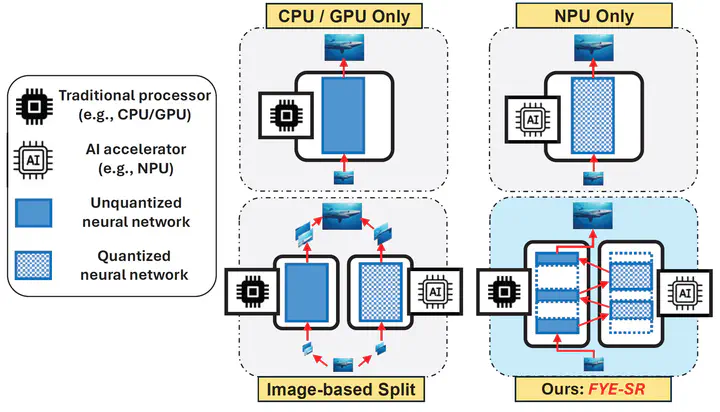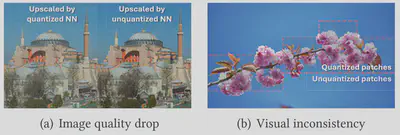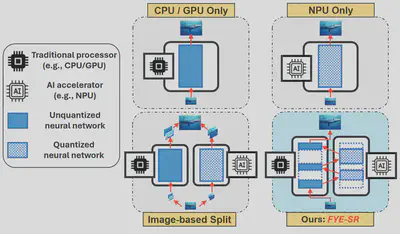Perceptual-Centric Image Super-Resolution using Heterogeneous Processors on Mobile Devices

Abstract
Image super-resolution (SR) is widely used on mobile devices to enhance user experience. However, neural networks used for SR are computationally expensive, posing challenges for mobile devices with limited computing power. A viable solution is to use heterogeneous processors on mobile devices, especially the specialized hardware AI accelerators, for SR computations, but the reduced arithmetic precision on AI accelerators can lead to degraded perceptual quality in upscaled images. To address this limitation, in this paper we present SR For Your Eyes (FYE-SR), a novel image SR technique that enhances the perceptual quality of upscaled images when using heterogeneous processors for SR computations. FYE-SR strategically splits the SR model and dispatches different layers to heterogeneous processors, to meet the time constraint of SR computations while minimizing the impact of AI accelerators on image quality. Experiment results show that FYE-SR outperforms the best baselines, improving perceptual image quality by up to 2×, or reducing SR computing latency by up to 5.6× with on-par image quality.
Background
Recent SOTA Image Super-Resolution (SR) techniques are mainly based on Neural networks (NNs) that can better capture such non-linearity and hence improve the image quality. However, NN-based SR models are computationally expensive for mobile devices with limited computing power. A better alternative is to involve specialized hardware AI accelerators that have been readily available in mobile SoCs, such as Neural Processing Units (NPUs), in addition to traditional processors (e.g., CPU and GPU) for faster inference. However, their use of fixed-point arithmetic could result in low quality in upscaled images when being applied to regression-based SR task.
To mitigate such image quality drop, existing schemes split input images into small patches and dispatch these patches to traditional processors and AI accelerators. However, when upscaled patches are re-stitched to form a complete image, such image-based split of SR computations often leads to color mismatch and visual inconsistency across image patches, as shown in the figure below. This inconsistency may not impact the structural image quality with a small portion of mismatching patches , but can largely affect the human perception of images.

Overview
Our Idea
Our work addresses the visual inconsistency
in upscaled images by introducing a new procedure-based
approach to splitting SR computations among heterogeneous
processors, as opposed to the traditional image-based split-
ting. As shown below, We split the SR model and adaptively
dispatch different NN layers of the SR model to heterogeneous
processors, according to the computing complexity
of these NN layers and how SR computations in these layers
are affected by the reduced arithmetic precision. Our goal
is to maximize the utilization of AI accelerators within the
given time constraints on SR computations, while minimizing
their impact on perceptual image quality.

System Design

As shown in the figure above, our design of FYE-SR consists of three main modules. During the offline phase, we first use a SR Timing Profiler to measure the computing latencies of SR model’s different NN layers on traditional processors (e.g., GPU) and AI accelerators (e.g., NPU), respectively. Then, knowledge about such latencies will be used to train a Model Split Learner to solve Eq. (2) for the optimal split of SR model.
During the online phase, FYE-SR enforces such model split, and uses a Data Format Converter to convert the intermediate feature maps into the right data formats (e.g., INT8 and FP32) for properly switching SR computations be- tween heterogeneous processors.
Results
As shown in the figures below, compared to other SOTA image SR approaches, our method could reach the overall optimal result considering both the structual image quality and perceptual quality, while meeting the preset deadline requirement.

Looking into the output images, FYE-SR can effectively suppress the distortions and visual inconsistency at detailed objects (windows on buildings).


